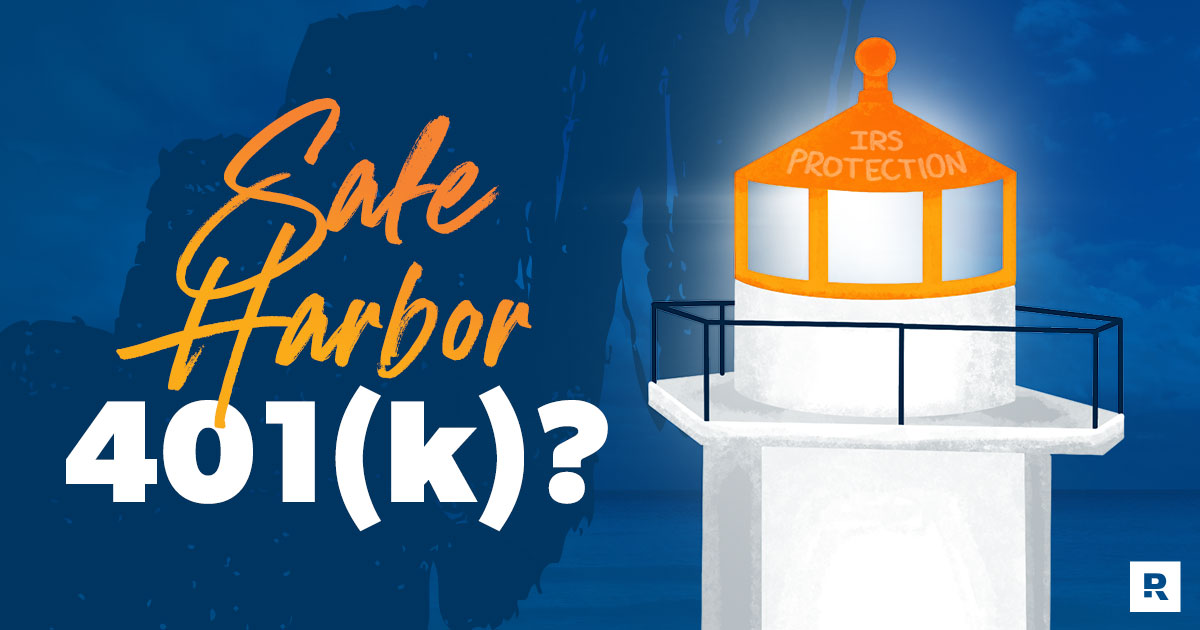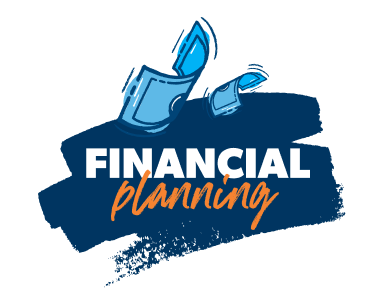
If you are a small-business owner, you are the backbone of the American economy—and we salute you!
One of your many responsibilities as a small-business owner is to find the best way to help your employees save for retirement. Maybe you’ve already set up a 401(k) plan at your workplace, but all the tests and hoops you have to jump through to meet the IRS’s rules and standards are driving you nuts.
That’s where the safe harbor 401(k) comes in to play. Nope, we’re not talking about retirement plans just for sailors or fishermen! Safe harbor 401(k)s are retirement plans designed to protect companies (small businesses, in particular) from getting in trouble with the IRS.
Let’s learn more about safe harbor 401(k)s and why they might be a great retirement plan option for your company!
What Is a Safe Harbor 401(k)?
A safe harbor 401(k) is a type of retirement plan that allows small-business owners to avoid the IRS’s annual nondiscrimination testing. But here’s the catch: Safe harbor plans require mandatory employer contributions and immediate vesting for employees (that means all employer contributions given to employees belong to the employees the moment those contributions hit their account).
Market chaos, inflation, your future—work with a pro to navigate this stuff.
Safe harbor plans are especially valuable for small businesses with fewer than 100 employees. Why? Because if their highly compensated employees and key employees invest too heavily into the company’s retirement plan, there’s a chance the plan might not pass those nondiscrimination tests, which could lead to some costly consequences!
Small-business owners and employees love the safe harbor option because it makes it easier to meet the rules set by the government and workers get some kind of contribution to their retirement plans. Everybody wins!
How Does a Safe Harbor 401(k) Work?
We’ve mentioned these “nondiscrimination” tests a couple times already, but what exactly is the deal here?
Basically, Uncle Sam wants to make sure that 401(k)s are set up in a way that doesn’t favor highly compensated employees (HCEs) over everyone else. These tests compare both plan participation and contributions of rank-and-file employees to owners and managers to make sure the plans are fairly benefitting both groups.
According to the IRS, there are three general nondiscrimination rules traditional 401(k) plans must follow:
- Highly compensated employees can’t contribute more than 2% of the average of all other workers who are eligible to participate in the company’s retirement plan.1
- HCEs also can’t receive more than 2% in employer contributions than what rank-and-file employees are receiving on average as a group.2
- The value of the assets in key employees’ retirement accounts cannot be more than 60% of all the assets held in an entire employer’s 401(k) plan.3
To show the IRS that a company’s 401(k) plan meets those requirements, the plan has to go through a series of annual nondiscrimination tests that are used to figure out whether or not the plan is fairly balanced.
What happens if your plan fails one or more of those tests? You’d have to make some corrections that could cost you a lot of time, money and paperwork to make sure your plan is compliant. You might even face penalties and have to refund 401(k) contributions made by some of your highly compensated employees, and they would then owe taxes on the money they got back . . . that would be really awkward and uncomfortable for everyone involved.
Larger businesses might have the team and resources in place to keep up with all those requirements, but it can get very time-consuming and expensive for smaller businesses to keep up with. And let’s be real, nobody wants to go through testing if they don’t have to!
A safe harbor 401(k) plan—with its mandatory employer contributions and immediate vesting for employees—can help your business sidestep that testing altogether because it is set up in a way that naturally meets the IRS requirements. That means you don’t have to lose sleep at night wondering if your 401(k) will pass the IRS’s tests! Plus, your HCEs can put in as much money as they want (up to the contribution limit) without having to worry about having that money returned to them.
Safe harbor plans also have the same contribution limits as traditional 401(k) plans.4 And with a safe harbor plan, your highly compensated employees can max out their contributions without having to worry about failing the nondiscrimination tests!
Keep Boosting Your Investing Know-How
Every two weeks, the Ramsey Investing Newsletter will send you practical insights, easy-to-use resources, and the latest investing news. All explained in plain English.
Types of Safe Harbor 401(k)s
If you wanted to have a safe harbor 401(k) for your business, you basically have three options.
The first two are matching options where your employees have to put money into their retirement account in order to receive contributions from their employer. And then there’s a third option where your company would have to make contributions across the board regardless of whether your employees contribute or not.
Let’s quickly run through each of those three options:
- Basic matching: This plan is also known as an “elective” safe harbor. In this case, the employer will match 100% of the first 3% of an employee's contributions. After that, the employer matches 50% of an employee's additional contributions, up to 5%.
- Enhanced matching: These plans are a little more straightforward than the basic matching plan because they usually offer a 100% match on up to 4% of an employee's contributions. Boom. Done!
- Nonelective contributions: With these plans, employers make a 3% retirement contribution for all workers, regardless of whether they choose to participate in the plan. So even if Sally in HR doesn’t put a single penny into her 401(k) this year, her employer still has to make contributions to her 401(k) account.5
These numbers are just minimums for a safe harbor match or contributions. If you want to be more generous and offer a matching safe harbor plan with a 5% match to your employees, knock yourself out!
And remember, whether you make matching or nonelective safe harbor contributions, that money is immediately vested when it hits your employees’ accounts. That means whether an employee has been at your company for 10 minutes or 10 years, those contributions belong to them completely.
What Are the Pros and Cons of a Safe Harbor 401(k)?
Let’s run through the benefits and drawbacks of a safe harbor 401(k) really quickly. Let’s start with the good stuff!
Pros
First, like we’ve mentioned again and again, you don’t have to worry about the IRS’s nondiscrimination testing every year. If your business has already failed those tests, a safe harbor 401(k) can help make your plan compliant in a snap.
Second, safe harbor 401(k)s can help boost participation in your company’s retirement plan across your company. If you choose a safe harbor plan with basic or enhanced matching, non-HCEs will be encouraged to put money into their 401(k)s so that they can get the employer match. And we’ve already talked about how your HCEs can max out their 401(k) contributions if they want to without worrying about the IRS slapping you or them on the wrist.
Cons
There are a couple of downsides to a safe harbor plan we have to talk about. The first, of course, is that there is a cost to making mandatory contributions. Implementing a safe harbor 401(k) could increase your payroll costs by 3% or more depending on what safe harbor option you choose and how much your employees decide to contribute into their plans.
There’s also less flexibility with a safe harbor plan. This is especially true when it comes to vesting—which is a term used to talk about how much of someone’s employer contributions belong to them if they leave their job. A company can provide an incentive for employees to stick around longer by putting them on a “vesting schedule” with a traditional 401(k) plan.
For example, you could put a new employee on a five-year vesting schedule where the company increases the amount they are vested in by 20% every year. If that employee leaves after three years, they can only take 60% of their employer’s contributions with them. They would have to stay five years before becoming fully vested—only then would they get to keep all of their employer’s contributions.
Safe harbor plans require immediate vesting, so you give that up when you put a safe harbor 401(k) in place at your company.
Get Help From a Financial Advisor
Trying to decide what kind of 401(k) plan is right for your business is a massive decision. And if you’re still on the fence about whether or not a safe harbor 401(k) is right for your business, you don’t have to make that decision alone!
Our SmartVestor program can connect you with a financial advisor who is ready to answer your questions and walk you through all of your options. That way, you can make the best decision for your business.
Make an Investment Plan With a Pro
SmartVestor shows you up to five investing professionals in your area for free. No commitments, no hidden fees.
This article provides general guidelines about investing topics. Your situation may be unique. To discuss a plan for your situation, connect with a SmartVestor Pro. Ramsey Solutions is a paid, non-client promoter of participating Pros.



